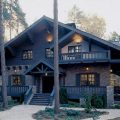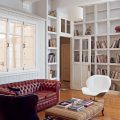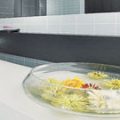one. It is always necessary to begin repair with the choice of suitable materials. Think about what kind of parquet / laminate or linoleum you want to see in the room and a tile in the bathroom, which, if anything, can be easily replaced in a few years with something more interesting. Decide whether you paint the walls or choose wallpaper for them, such as fabric. And do not forget about the ceiling! You can opt for a stretch ceiling or confuse with suspended plasterboard. Photo: Getty Images2.Include in the cost estimate an item on replacing windows (especially since developers often install low-quality options that are better to replace immediately) and doors (entrance and interior). The water supply and heating systems also need to be replaced with plastic pipes, they are more durable. 3. Estimate the cost of building materials (the price depends on the quality) and study the offers of specialized companies that do repairs (if you decide not to do the repairs yourself, but to entrust it to professionals). 4. If your apartment was rented without partitions (open layout), think about whether you need to install them and whether they will be made of brick or plasterboard. At the same stage, you need to clearly determine how many holes for sockets / switches you need and where they will be located. And, accordingly, cut holes and grooves for electrical wiring and pipelines. 5. The next stage is to distribute electrical wiring throughout the apartment (sockets, lighting, doorbell, washing machine, alarm, electric oven) and be sure to connect it to the apartment's electrical panel. Now you can lay out the sewer pipes to the bathroom, toilet and kitchen. The main thing is not to forget to connect the pipes for cold and hot water and install ventilation grilles. 6. Next, you need to plaster the walls, sand the ceilings, make door slopes and window openings. Think about whether you need additional niches for storage, if so, make the frames of shelves and built-in cabinets and prime them. 7. Let's move on to the floor. In the bathroom and toilet, it is imperative to waterproof the floor, pour the floor screed, and when it dries, you can install a sink and a bath / shower cabin. In the rooms, you can insulate the floor (also pour the screed and wait until it dries completely). After that, you can start finishing the ceiling and puttying the slopes and walls. Next, you need to paint the heating pipes and radiators (if you haven't changed them), lay the floor (laminate/parquet/linoleum/floor tiles), install window sills, sockets and switches. Now you can hang lamps, buy furniture and do the decor.
Photo: Getty Images2.Include in the cost estimate an item on replacing windows (especially since developers often install low-quality options that are better to replace immediately) and doors (entrance and interior). The water supply and heating systems also need to be replaced with plastic pipes, they are more durable. 3. Estimate the cost of building materials (the price depends on the quality) and study the offers of specialized companies that do repairs (if you decide not to do the repairs yourself, but to entrust it to professionals). 4. If your apartment was rented without partitions (open layout), think about whether you need to install them and whether they will be made of brick or plasterboard. At the same stage, you need to clearly determine how many holes for sockets / switches you need and where they will be located. And, accordingly, cut holes and grooves for electrical wiring and pipelines. 5. The next stage is to distribute electrical wiring throughout the apartment (sockets, lighting, doorbell, washing machine, alarm, electric oven) and be sure to connect it to the apartment's electrical panel. Now you can lay out the sewer pipes to the bathroom, toilet and kitchen. The main thing is not to forget to connect the pipes for cold and hot water and install ventilation grilles. 6. Next, you need to plaster the walls, sand the ceilings, make door slopes and window openings. Think about whether you need additional niches for storage, if so, make the frames of shelves and built-in cabinets and prime them. 7. Let's move on to the floor. In the bathroom and toilet, it is imperative to waterproof the floor, pour the floor screed, and when it dries, you can install a sink and a bath / shower cabin. In the rooms, you can insulate the floor (also pour the screed and wait until it dries completely). After that, you can start finishing the ceiling and puttying the slopes and walls. Next, you need to paint the heating pipes and radiators (if you haven't changed them), lay the floor (laminate/parquet/linoleum/floor tiles), install window sills, sockets and switches. Now you can hang lamps, buy furniture and do the decor.

Making Money with Desserts: Success Stories
Evgeniya Polischuk (Fedutinova) instagram:@evgeniyafedutinovavk.com/janeshomebaking– It all started with baking for family and friends. Gradually, I started posting photos of my baked goods on Instagram – and orders started coming in. I made my first custom-made cake on October 13, 2014, and a little earlier I started making macaroons and cupcakes. You could say that the business “found me”, I am very […]

Soups are cold recipes with photos
Cold cucumber soup with yogurt and lemonsorbet from the chef of the restaurant La Taverna Alexander Zhurkin Photo: Getty Images Ingredients: Plain yoghurt – 125 g Cucumber – 150 g Lemon/lime sorbet – 50 g Cocktail shrimp – 24 g Fresh ginger juice – 1 g Lime juice – 5 g Fresh orange juice – 5 g Parsley – 1 g Pink pepper – 1 g Watercress – […]

barbeque kebab
Pork tenderloin in glaze Photo:Dmitry Bayrak/dbstudioPreparation time: 20 minutes + marinating time.Calories: 454 kcal per serving.For 4 servings: 4 pork tenderloins (approximately 300 g each), 1 onion, 2 cloves of garlic, 1 tsp. lemon zest, 1 tsp. lemon juice, a pinch of ground cumin, coriander and turmeric, 1 tbsp. vegetable […]

Pierre Duacan: dietary recipes: Ducane diet
Beetroot soup Photo:Season’S, Luxury Hotels RepresentationYou will need:· Boiled beetroot – 60 g· Fresh cucumbers – 20 g· Red radish – 20 g· Green onions – 10 g· Egg – 1 pc.· Drinking mineral water – 200 g· Salt – 1 gPreparation:· Boil the egg and beetroot.· Grate the cucumbers, radish and part of the beetroot. Put everything […]





